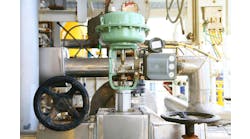VALVES FOR handling radioactive waste must sometimes include unconventional solutions. That’s what happened when Flowserve Corp. recently designed and implemented innovative valve and automation solutions for control, isolation, and treatment of radioactive waste slurries at the Hanford Waste Treatment Project (WTP) in southeast Washington State.
Hanford has one of the world’s largest concentrations of radioactive waste, which is the legacy of 45 years of plutonium production for nuclear weapons. The site contains 53 million gallons of high-level radioactive waste, 60% by volume of the nation's total, stored in 177 old, deteriorating underground tanks, located just seven miles from the environmentally sensitive Columbia River. An estimated 1 million gallons of waste have already leaked from 67 of the facility’s oldest tanks, and radioactive waste has been detected in the groundwater that flows to the Columbia, endangering the river habitat and the health of millions of Washington and Oregon residents downstream.
To remediate this hazard, the U.S. Department of Energy (DOE) commissioned a project for treating and converting the high-level radioactive waste to glass logs. “Vitrification” is considered the most effective treatment process for this type of contamination because it produces a durable, stable form that incorporates and immobilizes radioactive waste. Once immobilized, the high-level radioactive portion of the WTP’s waste will be temporarily stored at Hanford until it can be shipped to a federal geologic repository for permanent disposal. The low-level radioactive portion of the waste will be stored on-site.
DOE’s Office of River Protection contracted with Bechtel National Inc. in December 2000 to build the WTP, which it’s estimated will cost $5.7 billion and take up to 10 years to complete. It will be the world’s largest vitrification facility, and will include three nuclear facilities: one for pretreatment, a second for low-activity waste vitrification, and a third for high-level waste vitrification. Much of the project focuses on waste handling, so worker safety is never breached, and isolating and treating the waste is achieved.
In the initial treatment process, specialized valves were needed in WTP’s “bulges” containment vessels. Each bulge is roughly the size of a small swimming pool, and is designed to contain all the pumps, valves, and piping required to transfer the radioactive liquid waste slurry from the existing underground storage tanks to the pretreatment building for processing. The pretreatment system combines a filtration process that removes the solids from the waste slurry and an ion-exchange process that then removes soluble high-level waste from the remaining liquid. Guidelines for this part of the project required manual and automated valves that could be operated and repaired from outside the containment bulges to ensure worker safety and radioactive containment. All bulge valves were subject to NQA-1 inspection and documentation to meet strict DOE specifications. Bulge valve actuators and positioners also were specified to be mounted outside the containment barrier of each bulge.
To treat its 53 million gallons of high-level radioactive waste, the Hanford Waste Treatment Project (WTP) will feature the world’s largest vitrification and pretreatment facilities, including Flowserve’s plug valves and valve automation systems.
Based on its Durco G4 plug valve’s 35-year history tough-slurry and nuclear-power applications, Flowserve recommended its soon-to-be-released Durco Mach 1 top-entry plug valve, which could be modified for the remote operation and repair that Bechtel required. Flowserve also designed Mach 1 to allow a variety of valve seating materials, including the ultra-high molecular weight polyethylene (UHMWPE) needed to stand up to WTP’s radioactive slurries. “Mach 1 gave us the flexibility to build a solution for Bechtel,” says Fred Shanks, Flowserve Flow Control’s senior product engineer. “It was a remotely repairable valve that could have an UHMWPE seat that could be easily removed.”
In addition, Mach 1 required some added modifications at Flowserve’s facility in Cookesville, Tenn., to make it remotely repairable and fully radiation resistant. “UHMWPE is highly wear and radiation resistant, but it also requires higher torque levels,” adds Shanks. “Adjusting for the space constraints that Bechtel gave us to work with and the torque requirements of the Mach 1 with an UHMWPE seat was a delicate balancing act. It forced us to keep innovating with the valve’s design and what actuators we could use for it.”
To isolate and treat highly radioactive slurries in its “bulge” containment vessels, the Handford project needed stem extensions that could adjust to any length, and be operated and repaired remotely, so Flowserve designed extensions that could work for any valve in any position in the bulge.
Automating the Valves
The next challenge was qualifying Flowserve’s Automax valve automation systems with Bechtel, and building adjustable, stainless-steel extensions with double universal joints to enable remote operation and repair of the valves from outside the bulge vessels. Bechtel also required that valves be welded into the bulge piping at a 5º angle to promote drainage. Universal joints at the top and bottom of the extension were required to eliminate any side-loading that the 5º operating angle might create. Shaw and Larry Shields, Flowserve Flow Control’s senior sales engineer, worked with Vince Rohrig, the firm’s automation product manager, and Stan Piela, its special projects engineer, to design field-adjustable hardware for manual and automated operation of the bulge valves, regardless of orientation or distance from the top of the bulge vessels.
“Bechtel wanted stem extensions that could adjust to any length, so we came up with a design for the extensions that could work for any valve in any position in the bulge,” says Shaw. “Vince’s design allowed the extensions to be manufactured as a standard unit that was adjustable to any length during final installation.”
Rohrig adds, “We’ve done a lot of stem extensions, but nothing like these. Not only did the extensions have to telescope, they also had to be designed to take the weight of the stem extension off of the valves. Bechtel also had a variety of torque requirements for these valves, from 500 to 20,000 in.-lb.”
Consequently, Bechtel also qualified Automax pneumatic actuators with Foundation Fieldbus switches after some added Bechtel and DOE requirements were met. A more than $1 million contract for the bulge valves and automation was signed in August 2002 with Flowserve as the exclusive source. So far, Flowserve has worked with one of several bulge manufacturers to complete the first bulge containing 22 valves, and other bulge valve orders are in process.
Later, when Bechtel asked about Flowserve’s capabilities for WTP’s jumper valve portion, the team presented Bechtel with another modified Mach 1 valve with Automax stainless-steel, rack-and-pinion valve automation. These jumper valves had to be fully automated, so they could be used in the pretreatment building with the same requirements for radioactive slurry handling as the bulge valves. Because of the intense radioactivity in the pretreatment building, the jumper valves were to be operated and repaired remotely by robotics. These valves also were specified with radiation-resistant pneumatic actuators, switches, and accessories to be mounted directly on the valve bodies.
Unlike the bulge valves, however, the jumper valves couldn’t be built with stem extensions for pulling the plug and sleeve out of the valve body for repair. The challenge was to develop a “jack nut” feature that would enable remote release and replacement of the plug and sleeve cartridge assembly by a robot.
In addition, design changes were required to modify the actuators and mounting kits, so the actuation packages could be removed for access to the top of the valve for cartridge replacement. Also, space constraints forced Flowserve to propose smaller, stainless-steel Flowserve Worcester Controls rack-and-pinion actuator units, not previously manufactured with stainless-steel materials, in place of larger, standard Automax stainless steel actuators originally proposed.
“The pretreatment building is a huge facility with lots and lots of equipment,” says Shaw. “Everything is installed very close together. It became apparent that we had to build a very compact automation package. Bechtel gave us specific space dimensions that we had to meet. So we had to be flexible in what we were offering to meet requirements.”
Bechtel next wanted proof that the actuators would meet NQA-1 inspection requirements, and that Flowserve would meet promised delivery schedules. After satisfying these requirements, Flowserve received another multi-million dollar order for the automated jumper valves in August 2004.
“We worked very hard to gain Bechtel’s confidence so we could design valve and automation packages that would meet the needs of their applications and facilities,” adds Shields. “We came up with two plug valve designs that were unique. That’s what put us ahead of the competition.”



